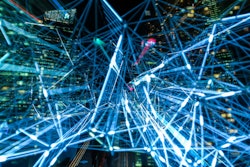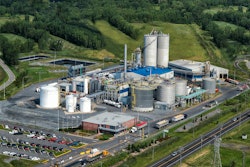
Advanced Industrial Marketing (AIM) announced it is launching new social distancing and people counting tools in the U.S. Piloted in Europe, the two products, EGOpro Active Tag and LASE PeCo, are being used in industrial warehousing facilities and large retailers to ensure employees and customers observe social distance restrictions.
The COVID-19 pandemic has reshaped how businesses operate around the globe. Manufacturing facilities, warehouses and meat packaging plants are conducting essential work, but it may be difficult to adjust to and maintain the six-foot CDC-recommended social distancing guidelines. The EGOpro Active Tag takes the guesswork out of social distancing.
This wearable tech utilizes UWB radio technology to measure the distance between two tags with a constant radio pulse. When two tags – and the people wearing them – are too close to one another, the tags vibrate and flash a red LED. This alerts the user and those around them that they have breached a minimum safe distance. In addition to wearable tags, sensors can be set in facility “hotspots” like entrances, break rooms and bathrooms to ensure social distancing is maintained off the floor and in heavily trafficked areas.
“The usage of this technology in the current pandemic is groundbreaking,” says Rob Hruskoci, owner and CEO of Advanced Industrial Marketing. “Employees can see how much room they have to work with one another, and employers can use this data to reconfigure workspaces to maintain the minimum safe distance while operating.”
The tags are currently wearable on an individual’s wrist or belt, but there are opportunities to deploy them more widely, such as on shopping carts in grocery stores or with self-guided tour technology at museums.
Each EGOpro Active Tag is equipped with a unique serial number and has the potential to be connected to a custom software solution. This can be used for counting the number of people in a given area, keeping track on how long they are in certain areas, and even sending alerts to managers if there is overcrowding. Additionally, in a situation where a facility may have been exposed to COVID-19, the software could be used for contact tracing using the device’s individual serial numbers.
Even before COVID-19 circled the globe, venues needed a way to measure traffic, venue capacity and busy or quiet areas to reduce wait times or congestion. This capacity verification technology has also been adapted to today’s social distancing guidelines. Also called “people counting,” capacity verification uses 3D cameras to measure the number of people in a given area. LASE PeCo has specialized in using multiple technologies to monitor passenger frequency in industrial, municipal and entertainment locations for more than 25 years.
Today, the LASE Pe(ople)Co(unter) uses standalone 3D cameras to measure how many people are in a small space, such as an art gallery. For larger locations, like food courts or college campuses, LASE PeCo deploys its laser solution that uses a laser grid system to measure the number of people within the open space.
“The laser technology is smart enough to tell the difference between adults, children and shopping carts, but it can’t discern gender or any other identifying features as part of a surveillance system,” explained Hruskoci. “When the system detects too many individuals in a given area, it sends an alert to the designated manager on duty to break up any overcrowding.”
The PeCo software is highly customizable and can send alerts via email or text to managers. This software can also be integrated with gates, doors or alarms to notify people in the area when there is too much crowding or the area has reached maximum capacity.
As economies reopen and buildings, venues and businesses incorporate social distancing guidelines for visitors and employees, these non-invasive, customizable technology solutions can help streamline the process to optimize efficiency while keeping individuals safe.














